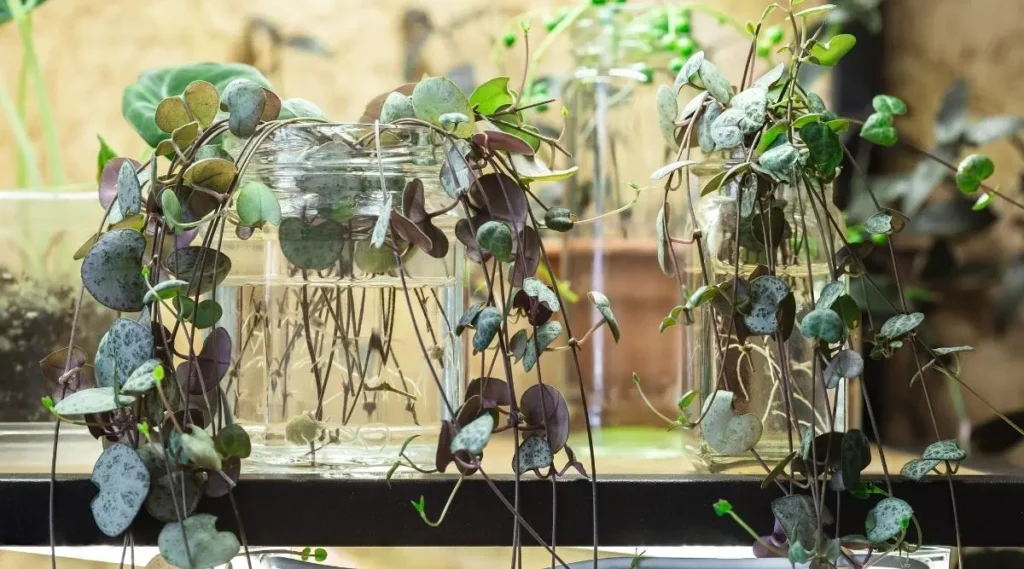Explore how to propagate string of heart plants, an enjoyable way to build your stock of these attractive hanging beauties. Various methods exist to create new growth, either for plant maintenance or as shared division pieces. With the right technique and a little patience, you can transform cuttings into thriving vines, bringing more of this delicate, heart-shaped charm into your home!
Multiply Your String of Hearts
You should learn how to propagate string of hearts when the plant actively grows, mostly during spring and summer. The combination of elevated temperatures and extended daylight duration helps promote effective root growth, leading to vigorous new plant development. When dormant during winter, the plant propagation process becomes slower, with higher probabilities of failure, so it is best to avoid this period. Your Miltoniopsis plant flourishes best when you select propagation time during its active phase.
Best Time for Propagation
You should propagate String of Hearts when the plant actively grows, mostly during spring and summer. The combination of elevated temperatures and extended daylight duration helps promote effective root growth, leading to vigorous new plant development. When dormant during winter, the plant propagation process becomes slower, with higher probabilities of failure, so it is best to avoid this period. Your Miltoniopsis plant flourishes best when you select propagation time during its active phase so new cuttings can develop strong roots that create beautiful trailing vines.
Simple Steps to Propagate String of Hearts
Here are the simple steps to know better how to propagate string of hearts using the Stem-Cutting Method:
Choose Healthy Stems
Select leafy, green stems from a pest-free, thriving plant. Choose stems which exclude brown spots and other distressing signs because healthy cuttings will have better rooting success rates.
Trim the Stems
Cut your strings into groups of 7.6 to 12.7 cm (3 to 5 inches) each with regular garden scissors. Taking multiple cuttings simultaneously will improve the propagation’s success.
Remove Lower Leaves
Remove all leaves which extend below the first third of the stem length. The leaf nodes become accessible to encourage root development.
Apply Rooting Hormone (Optional)
When treated with rooting hormone, your cut ends will develop roots more efficiently. During this process, leave the cut stems to dry on their own for 15-20 minutes.
Increase Humidity
Accelerate your cuttings’ root development using a plastic bag or appropriate container to hold moisture.
Provide Adequate Light
Put your cuttings by a south-facing window where they get plenty of sun, exposing light from that direction.
Monitor Root Growth
Root development usually occurs during four weeks. Keep changing the weekly water intake to stop bacterial growth.
Grow New Plants from Root Cuts in Water or Soil
Water Propagation: Set your stems inside a water glass while keeping all leaves above the surface.
Soil Propagation: Establish vigorous roots by planting stems into loose, well-draining soil directly inside pots.

Effortless Butterfly Propagation Growth
Here are the key points on Effortless Butterfly Propagation Growth from the Butterfly Method. Take a look at how to propagate string of hearts:
Choose Healthy, Leafy Stems: Select stems with multiple sets of leaves to ensure you have enough for rooting. For the best results, these stems should be free from pests and damage.
Trim the Stems Into Pieces: Cut the chosen stem into 1-2 inch long pieces, ensuring each piece has two leaves. The cut pieces will grow roots from the nodes where the leaves are attached.
Use Damp Sphagnum Moss: Soak sphagnum moss in water for 5 minutes before completely draining it before using it in your container. The moss functions by sustaining water moisture levels and creating an environment that promotes rooting.
Arrange Cuttings on the Moss: Lay the trimmed stem pieces with the leaf nodes touching the damp moss. Space them out to allow for a lush, fuller plant as they root.
Cover for Humidity: To improve moisture levels, cover the container with clear plastic wrap. The moss helps keep moisture levels high as the rooting initiative process increases.
Place in Bright Indirect Light: A south-facing window should be your preferred location to keep the container exposed to light. This placement method provides protection against excessive sunlight intensity, as your cuttings will receive essential light energy from the sun.
Power of Tubers in String of Hearts Propagation
Here are a few key points for learning about how to propagate string of hearts from the stored information:
Natural Rooting Nodes
Tubers are small bulbs (pea-sized to 1-inch long) that develop along the stems and serve as natural rooting points. They can be gently pressed into the soil while still attached to the plant to encourage root growth without cutting.
Easy Propagation for Fuller Growth
If your String of Hearts looks sparse, burying the tubers halfway in the soil allows them to root and sprout fresh vines, helping to fill out the plant over time.
Separate for New Plants
Once the tubers develop roots, you can carefully detach them from the main vine and transplant them into a new pot, effortlessly creating an entirely new plant.
Master Stem End Rooting
Here are key points for Master Stem End Rooting from the stored information:
Prepare a New Pot
Fill a pot with well-draining soil, mixing in perlite or sand for better aeration. This will be the base for your new plant.
Lay Stems Over Soil
Take long vines from your existing plant and place the ends over the new pot’s soil. If there are tubers on the stems, they will help in root formation.
Press Tubers Into The Soil
If any stems have small tubers (pea-sized to 1 inch), gently push them halfway into the soil to encourage faster root growth.
Wait for Root Growth
Keep the soil moist and wait about a month for roots to establish. Once rooted, cut the stems a few inches above the new roots to separate into a new plant.
Frequently Asked Question
What’s The Easiest Propagation Method?
The Butterfly Method and Water Propagation are the simplest and most effective.
Can I Propagate In Water?
Yes! Submerge leaf nodes in water, change it weekly, and transplant once roots are 1 inch long.
Why Aren’t My Cuttings Rooting?
Ensure warmth, humidity, and bright light. Avoid dry conditions and unhealthy cuttings.
Conclusion
An effortless and rewarding experience to learn how to propagate string of hearts through which you can enhance your plant collection or achieve fuller, more vibrant displays. You can choose from four effortless methods to promote new growth through careful treatment and waiting time among stem-cutting butterfly and tuber propagation and stem end rooting. You can successfully multiply this delicate trailing beauty by selecting healthy stems, providing the right environment, and monitoring root development. With time, your propagated cuttings will transform into lush, cascading vines, adding charm and elegance to any space!



